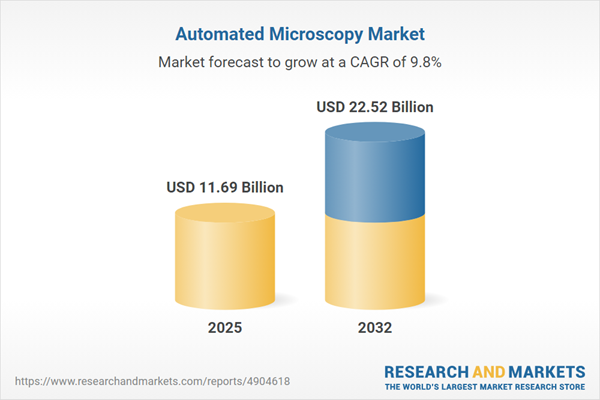Speak directly to the analyst to clarify any post sales queries you may have.
The automated microscopy market is rapidly evolving as organizations in science and industry seek greater precision, higher throughput, and advanced analytics to optimize cellular, molecular, and material investigations. As laboratories transition to sophisticated integrated systems, automation becomes pivotal for driving reliable discoveries and operational efficiency.
Market Snapshot: Automated Microscopy Market Size and Growth
The automated microscopy market grew from USD 10.65 billion in 2024 to USD 11.69 billion in 2025, advancing at a robust CAGR of 9.81%. This trajectory is set to reach USD 22.52 billion by 2032. Surging research demands, regulatory compliance, and digital transformation initiatives continue to influence expansion, as end users pursue scalable, data-rich platforms for diverse applications.
Scope & Segmentation: Comprehensive Industry Coverage
- Product Types: Instruments, Services (Consulting Services, Installation & Maintenance, Training & Support), Software (Data Management Software, Image Analysis Software, Visualization Tools)
- Technology Platforms: Electron Microscopy (Scanning Electron Microscopy, Transmission Electron Microscopy), Optical Microscopy (Brightfield, Confocal, Fluorescence, Multiphoton, Phase Contrast), Scanning Probe Microscopy (Atomic Force Microscopy, Scanning Tunneling Microscopy), X-Ray Microscopy
- Applications: Academic Research & Teaching (Life Sciences, Multidisciplinary Education, Physical Sciences), Clinical Pathology (Cytopathology, Histopathology), Drug Discovery & Development (Clinical Trials, Preclinical Research), Material Science (Metals & Alloys, Nanomaterials, Polymers)
- End Users: Academic & Research Institutes, CROs & CMOs, Hospitals & Clinical Labs, Industrial & Materials Companies, Pharmaceutical & Biotech Companies
- Deployment Models: Cloud-Based, On-Premises
- Regional Coverage: Americas (North America: United States, Canada, Mexico; Latin America: Brazil, Argentina, Chile, Colombia, Peru), Europe, Middle East & Africa (Europe: United Kingdom, Germany, France, Russia, Italy, Spain, Netherlands, Sweden, Poland, Switzerland; Middle East: United Arab Emirates, Saudi Arabia, Qatar, Turkey, Israel; Africa: South Africa, Nigeria, Egypt, Kenya), Asia-Pacific (China, India, Japan, Australia, South Korea, Indonesia, Thailand, Malaysia, Singapore, Taiwan)
- Key Companies: Thermo Fisher Scientific Inc., Danaher Corporation, PerkinElmer, Inc., Agilent Technologies, Inc., Carl Zeiss Microscopy GmbH, Nikon Corporation, Olympus Corporation, Bruker Corporation, Yokogawa Electric Corporation, Becton, Dickinson and Company
Key Takeaways for Senior Decision-Makers
- Artificial intelligence and advanced analytics are now central to workflow automation and image interpretation, resulting in more actionable data and streamlined operations.
- Remote access, modular system configurations, and cloud-based ecosystems support global collaboration, enable virtual monitoring, and increase laboratory productivity.
- Segmented offerings—ranging from hardware and consulting to software and managed services—allow users to tailor adoption strategies according to operational scale and research objectives.
- Adoption of sustainable practices and energy-efficient hardware is gaining momentum, aligning with broader institutional goals for green laboratories and responsible procurement.
- Vendor strategies emphasize open architectures, software interoperability, and end-to-end service models to enhance customer experience and future-proof investments.
Tariff Impact: Navigating U.S. Regulatory Changes and Global Supply Chain Realignment
Recent United States tariff adjustments affecting advanced microscopy instrumentation and components have pressured global supply chains, driving equipment price increases and shifts in sourcing strategies. Manufacturers are responding by diversifying suppliers, localizing production, and forming international partnerships to mitigate disruption and maintain innovation. Some end users are adopting rental or service-based procurement models to navigate budget volatility and ensure research continuity.
Methodology & Data Sources
This report utilizes a robust multi-phase research methodology combining primary interviews with industry stakeholders and structured surveys targeting laboratory management and procurement. Insights are validated through cross-referencing deployment case studies and authoritative secondary sources, including white papers and regulatory filings, with additional checks for data integrity and alignment across all market dimensions.
Why This Report Matters
- Delivers actionable intelligence to support data-driven investment and procurement strategies in the automated microscopy sector.
- Equips leaders with comprehensive analysis of evolving technologies, regulatory developments, and region-specific dynamics to drive competitive differentiation.
- Enables effective planning for risk mitigation, innovation adoption, and long-term market positioning amidst ongoing geopolitical and regulatory shifts.
Conclusion
As the automated microscopy market advances, success will hinge on strategic technology integration, resilient supply chains, and alignment with regulatory and sustainability trends. This report provides senior decision-makers with the clarity needed for informed action in a complex, global landscape.
Additional Product Information:
- Purchase of this report includes 1 year online access with quarterly updates.
- This report can be updated on request. Please contact our Customer Experience team using the Ask a Question widget on our website.
Table of Contents
3. Executive Summary
4. Market Overview
7. Cumulative Impact of Artificial Intelligence 2025
Companies Mentioned
The companies profiled in this Automated Microscopy market report include:- Thermo Fisher Scientific Inc.
- Danaher Corporation
- PerkinElmer, Inc.
- Agilent Technologies, Inc.
- Carl Zeiss Microscopy GmbH
- Nikon Corporation
- Olympus Corporation
- Bruker Corporation
- Yokogawa Electric Corporation
- Becton, Dickinson and Company
Table Information
| Report Attribute | Details |
|---|---|
| No. of Pages | 199 |
| Published | October 2025 |
| Forecast Period | 2025 - 2032 |
| Estimated Market Value ( USD | $ 11.69 Billion |
| Forecasted Market Value ( USD | $ 22.52 Billion |
| Compound Annual Growth Rate | 9.8% |
| Regions Covered | Global |
| No. of Companies Mentioned | 11 |









